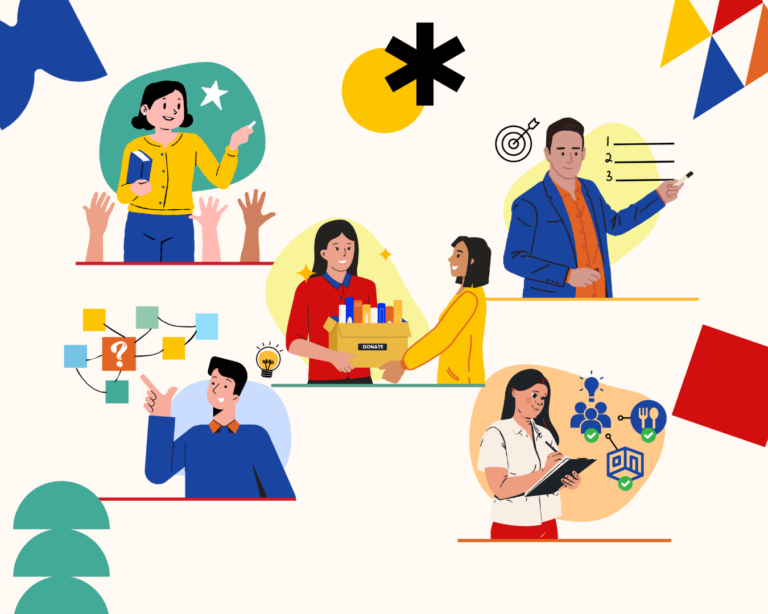Last June 2015, the Kinderhabi team traveled some 10-12 hours by land to head to the Bicol region. It was a long and bumpy ride— hardly noticeable because of the excitement as we looked forward to our first early childhood education project outside NCR.

Just arrived! Ivy in front of our home for the next few days
Kinderhabi is the official arm built to take on Habi’s projects in early childhood education and development. In collaboration with MovEd Foundation and the local government unit, the team facilitated a training program for the day care workers selected from the different barangays. One of MovEd Foundation’s main thrusts is to equip existing day care workers with tools to assist their development as preschool teachers. Kinderhabi took this into account and came up with a scope of work that is two fold: (1) designing a training module and (2) facilitating a 2-day workshop to introduce early childhood education concepts while contextualising the lessons so it adapts to the needs of the local community.
In designing the workshop, the team decided to narrow in on three aspects of the day care workers’ life – her personal self, her professional self as a teacher, and how her work impacts the community. The workshop covered concepts ranging from self discovery, developmental milestones, classroom management and teaching strategies. We ended up with an integrated framework that conjoins MovEd Foundation’s suggested curriculum, the Department of Education’s Early Child Care and Development (ECCD) checklist and Habi’s philosophies.
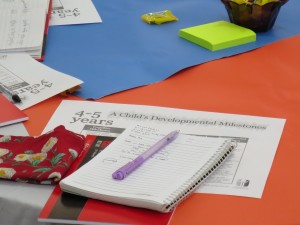 Given geographic limitations (Naga City is 350+ km away from Quezon City), the team wasn’t able to conduct a proper needs assessment prior to the workshop. As we brainstormed on the training program, we relied on previous work experience and theoretical knowledge of early childhood concepts. We considered this limitation and allotted 2 hours at the beginning of the workshop for goal setting and baseline assessments. Through this informal needs assessment, special topics on self-motivation and community involvement were subsequently added to the workshop proper.
Given geographic limitations (Naga City is 350+ km away from Quezon City), the team wasn’t able to conduct a proper needs assessment prior to the workshop. As we brainstormed on the training program, we relied on previous work experience and theoretical knowledge of early childhood concepts. We considered this limitation and allotted 2 hours at the beginning of the workshop for goal setting and baseline assessments. Through this informal needs assessment, special topics on self-motivation and community involvement were subsequently added to the workshop proper.
Throughout the facilitation of the workshop, we began to unearth unique characteristics of our participants. We discovered that they work in schools that are far from the city center. Almost all of them lack financial support to provide materials and basic utilities for their classroom. With this context in mind, the team devised ways to adjust longstanding theories to adapt to their specific needs.
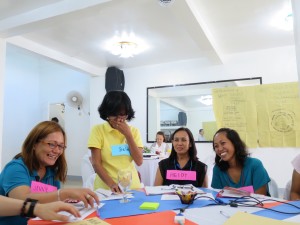
A lighthearted moment during one of the lesson blocks
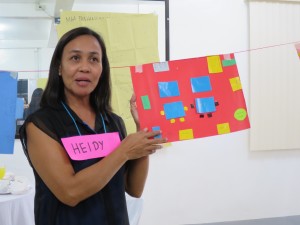
Teacher Heidy shows her classroom design during the gallery walk
One of the concepts that can be found in a typical Habi workshop is the idea of deeper learning, where we highlight the importance of ownership and application of stored knowledge. The three elements of deeper learning—saysay, husay and sarili—served as the guiding principles that were used to sew the several activities together. Saysay, for instance, was the principle behind the lesson blocks wherein the team introduced concepts theories to the group. These lessons were interspersed within the two day time frame. Luckily, with a small pool of participants (they were nine), we were able to discuss with each other in a relaxed pace. Husay was practiced during the activity blocks, the avenue where they applied the ideas presented to them. The Do It Yourself: Classroom, a 2 hour interactive activity that ended with a gallery walk, gave the teachers an avenue to showcase their ideas on classroom design while incorporating the different learning zones. They were also given opportunities to practice storytelling, a cornerstone of early childhood teaching. The third element, sarili, manifested itself during the sharing of best practices and open discussions. The participants had unique contexts but had enough shared experiences to create a communicative atmosphere. The open discussions were spurred by the fact that they sought to find ways to create solutions for one another. The concept of Sarili took center stage as the day care workers voluntarily decided to translate a classic circle time song into the local language, Bikolano.
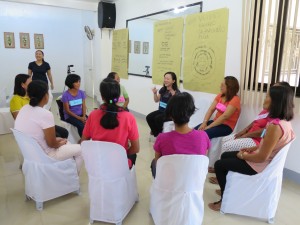
Singing a circle time song with appropriate gestures
It turned out to be a meaningful activity that started out with the participants’ desire to take ownership of the song. They took turns in adjusting the melody to suit the local words and found ways to incorporate the same rhythm. The experience of owning not only the song but also the activity reflected the ideals of the deeper learning concept. It was a definitive point as the teachers began to realize their collective potential and the opportunity to localize lessons that followed. As we continued to weave together a tapestry of shared ideas and lessons, we eventually created a meaningful atmosphere for everyone. It evolved into an exciting learning environment where we freely exchanged ideas and found ways on how to localise more concepts.
It was a definitive point as the teachers began to realize their collective potential and the opportunity to localize lessons that followed. As we continued to weave together a tapestry of shared ideas and lessons, we eventually created a meaningful atmosphere for everyone. It evolved into an exciting learning environment where we freely exchanged ideas and found ways on how to localise more concepts.
As the workshop ended, the initial buzz prior to the trip slowly waned alongside it. This served as an integral point for the Kinderhabi team members as we took a step back and reevaluated our objectives for the workshop. Our initial plans were to merely empower and equip the participants with tools and hope that the new lessons are echoed back into the classroom and community. We didn’t plan for the bigger chunk of work that lies during post-workshop— the monitoring and evaluation phase. How do we track if the lessons are appropriate for the classroom? How do we evaluate actual classroom settings? What data must we gather to inform our work during the next workshops? How do we ensure that workshop participation of teachers correlates to better student performance?
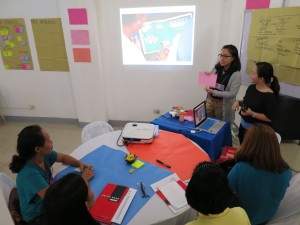
Pia J and Ivy facilitating the workshop sessions
We feel fortunate that the daycare workers, or preschool teachers, are clearly invested in the education of their students. Given the level of their participation and quality of insights during the workshop, we see how each one of them is continuously driven to learn and find resources to optimise their work. The ball is in Kinderhabi’s court. What are the next steps we must take? Two days worth of training that is packed with new topics and interactive tools may be thrilling for the meantime; now how can this be translated to reflect the nature of an authentic learning atmosphere that is updated, continuous and sustainable?

